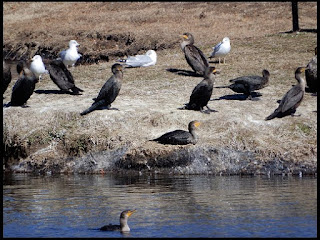 |
| Entry to Coppell |
Coppell is situated on the original land grant that J. A. Simmonds received from Peters Colony. It is marked by the Elm Fork of the Trinity
 |
| Duck Pond |
James Parish, from Goliad, was one of the early settlers, arriving during
 |
| Housing around cemetery |
By 1936 the Work Projects Administration had discovered Coppell, building a park with three bridges, a dam, and walkways. During the
 |
| Anahinga and seagulls at duck pond |
Developers purchased large tracts of land on which to build houses, but
 |
| Top: Parrish Cemetery Bottom: Confederate grave |
Interesting, but slightly disappointing since we couldn’t actually enter the grounds, is The Historic Bethel Cemetery (just south of 698 Christi Lane, Coppell, TX 75019). It is also on land donated by James Parrish in
 |
| Top: Bethel Cemetery Bottom: Cemetery grounds |
Stringfellow-Moore Cemetery (between 516 and 524 Carter Dr., Coppell, TX 75019) is on a hill behind two very nice, large homes. We
 |
| Top: Entrance to cemetery Bottom: WW2 grave |
The Historic Bullock Cemetery (151 Washington Ct, Coppell, TX 75019) is quite nice, with benches to rest on and lots of shade trees. The folks next door have a good view of it from their swimming pool. The
 |
| Left: Confederate grave Right: Bullock Cemetery |
Wandering around in the wind and cold made us hungry so we ventured into one of Coppell’s many restaurants for a snack. For information about my rating system, see Reading the Reviews.
 |
| Four carrots |
J. Macklin’s Grill (130 N Denton Tap Rd #120, Coppell, TX 75019, 972-393-0200) has some really interesting food. It is described as, ‘a grill-
 |
| Top L to R: Menu, Restaurant area Bottom L to R: Chicken tacos, Club sandwich |
 |
| Looking out from the cane stand |
©2018 NearNormal Design and Production Studio - All rights including copyright of photographs and designs, as well as intellectual rights are reserved.
No comments:
Post a Comment